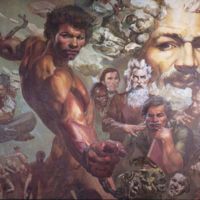
Life and Times of Frederick Douglass
In 1972, artist LeRoy Foster created this mural for the Douglass Branch of the Detroit Public Library. The mural depicts a meeting between Frederick Douglass and John Brown that took place on March 12, 1859, seven months before Brown’s raid on Harper’s Ferry. The mural contains three likenesses of Douglass in various stages of his life – the most prominent being the shirtless figure in the centre of the mural. The second largest figure of Douglass portrays him with the leonine, statesmen persona that he embodied later in his life. Finally, the smallest Douglass likeness is the seated figure speaking with John Brown. This small scene marks a pivotal moment in Douglass' life. In 1859 he had to make the decision between fighting with Brown (embodying the chain-breaking version of himself in the mural), or surviving to become a political leader. Choosing not to take up arms at Harper's Ferry, an attack that led to the execution of Brown for treason, Douglass chose the elder statesman person - and lived to 1895.
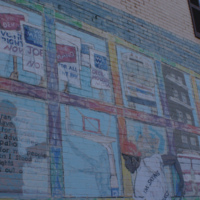
The Dignity of Work
In 1989, muralist Alfred Smith painted a mural in Anacostia, D.C., near Frederick Douglass’ residence during the last years of his life. It depicted the silhouette of Douglass alongside scenes from a labour protest. The mural, titled The Dignity of Work, contains a quotation from a speech by Douglass in 1888 before the International Council of Women. The mural had been destroyed by 2016.
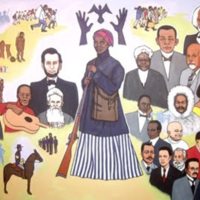
From Africa to America
Wilfred R. Stroud created this seven-panel mural in 1988 to be installed on the first floor of the Tubman Museum. It remains a signature piece in the Museum’s collection today. When the mural was being created, Stroud expained: “The purpose of this mural is to present a visual history of the black man and woman from the earliest times in Africa to the present times in America. The panels focus attention upon the impact of outstanding persons, and events that made a change in the lives and conditions of black people in particular, and the world in general.” Stroud dedicated an entire panel to the topic of slavery. Harriet Tubman stands in the centre, holding a rifle and surrounded by other antislavery leaders: Sojourner Truth, Abraham Lincoln, Frederick Douglass and John Brown.
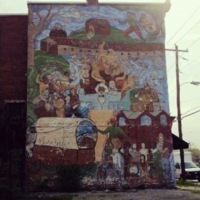
Neighborhood Center Mural Project
In July 1979, the city of Harrisburg saw a slice of its history on a wall at 610 Maclay Street. Painted under the direction of Toni Truesdale, the main theme of the mural was the history of the Underground Railroad in Harrisburg, along with a famous visit from Frederick Douglass and William Lloyd Garrison. In 1847, after both Garrison and Douglass returned from speaking tours in England, the two abolitionists decided to travel to Ohio to speak. Meeting in Philadelphia and speaking at other Pennsylvanian cities along the way, Douglass and Garrison reached Harrisburg on August 7, 1847. Garrison felt the city was “very much under the influence of Slavery. I do not anticipate a quiet meeting.” Garrison successfully finished his speech at the Dauphin County Court House to a full audience. But as Douglass reached the stage, audience members threw eggs. Douglass proceeded with his speech until he was interrupted by firecrackers. Someone also threw a stone at him. He observed that “the atrocious character of the proceedings is sufficiently palpable, and Harrisburg one day will be ashamed of it.”
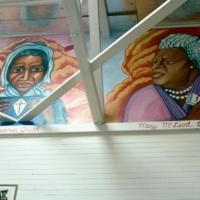
The Great Cloud of Witnesses
In 1992, Selma Brown, Susan Cervantes and Ronnie Goodman painted images of the antislavery leaderes Sojourner Truth, Harriet Tubman and Frederick Douglass, as well as Mary McLeod Bethune, W.E.B. Du Bois, and Thurgood Marshall, at Ingleside Presbyterian Church and Community Center in San Francisco, California. The mural, titled The Great Cloud of Witnesses, was started by Revered G. when he pasted a single newspaper clipping of his hero, Muhammad Ali to the wall of the church gymnasium in 1980. Over the decades, the collage expanded to cover the entire gym, fellowship hall, stairways, hallways, bathrooms, basement and meeting rooms. The mural is multi-faceted and contains newspapers, magazine clippings, photographs, flyers, posters, prints, poetry and painted murals.
![Cletus Alexander, Frederick Douglass Inspiring the Youth of the Negro Race, MacFarlane Middle School, Dayton, OH, 1933 [now in Dayton Art Institute] (2).jpg Cletus Alexander, Frederick Douglass Inspiring the Youth of the Negro Race, MacFarlane Middle School, Dayton, OH, 1933 [now in Dayton Art Institute] (2).jpg](https://486312.frmmmguz.asia/files/square_thumbnails/25a4cf3110ae30cf50088118e9193e7b.jpg)
Frederick Douglass Inspiring the Youth of the Negro Race
In 1933, Cletus Alexander, a student at Dayton Art Institute, submitted designs for a mural titled Frederick Douglass Inspiring the Youth of the Negro Race. Douglass is depicted as a biblical, Moses-like figure with flowing hair and a white beard, wearing traditional red and white robes. Towards the top of the mural are the words from Langston Hughes’ poem, Youth: “We have to-morrow, Bright before us, Like a flame, yesterday a night-gone thing, A sundown name, And dawn today, Broad arch above the road we came, we March!” At the time the mural was painted, it was housed in the MacFarlane Middle School building. After that building was destroyed in 2005, it was removed, restored, and is housed in the Dayton Art Institute.
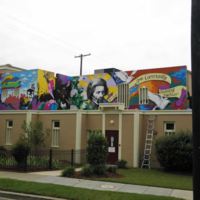
Bread for the City
In 2011, muralist Aniekan Udofia painted Bread for the City in Anacostia, D.C., close to the historic site of Frederick Douglass' house. The mural depicts Douglass in the younger, radical phase of his life, surrounded by doves and children, and the words “One People,” “One Community,” and “Building Together.” By 2016, the mural had been destroyed.
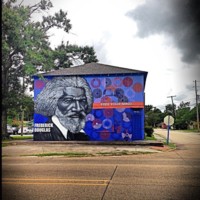
Free Your Mind
In 2013, Rahmann Statik painted two murals on the sides of a building in Beauregard Town, Baton Rouge. The murals cover the entirety of the building’s façade and reads, “Free Your Mind” alongside an image of Frederick Douglass, whilst the likeness of Harriet Tubman decorates the other side of the wall. Statik grew up on the southside of Chicago, surrounded by murals, and trained at the American Academy of Arts before working with Gallery 37 to teach mural creation to children. As of 2014, the mural no longer exists.
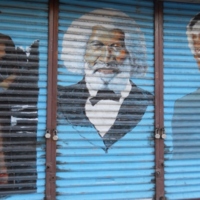
Tubman, Douglass, Mandela
This mural was created in 2008 by an unknown artist. Painted on a storefront on Ralph Avenue in Brooklyn, it depicted Harriet Tubman, Frederick Douglass and Nelson Mandela. As of 2014, it no longer existed.
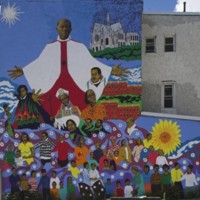
Father Paul Washington
Walter Edmonds memorialised Father Paul Washington of the Philadelphia Church of the Advocate, on the side of a building in the Strawberry Mansion district of Philadelphia in 1990. Father Washington was a prominent social activist in the area of Philadelphia.The creation of this mural is a good example of the call-and-response relationship generated by communities. After Walter Edmonds painted the mural Father Paul Washington, local residents were not satisfied with the likeness. As a result, Washington’s face was repainted by artist Stuart Yankell. Washington stands with arms outstretched surrounded by other local and famous heroes, including the antislavery leader Frederick Douglass.
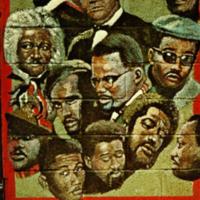
Nation of Islam
In 1990, this mural titled Nation of Islam at Charles Place in Brooklyn was created. The mural unites many radical figures of black history, including the antislavery leader Frederick Douglass, W.E.B. Du Bois, Elijah Muhammad, H. Rap Brown, Malcolm X, Marcus Garvey, Eldridge Cleaver and Bobby Seale. It has now been destroyed.
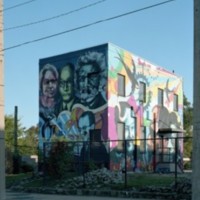
Seven Hills School Mural
Ed Trask, a Richmond-based muralist, created this mural in 2011 at the Seven Hills School in Richmond. It depicts the antislavery leader Frederick Douglass, as well as local figures Maggie Walker, Oliver W. Hill and Spottswood Robinson III. The other side of the building depicts Langston Hughes and W.E.B. Du Bois.
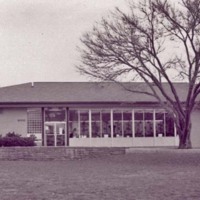
Odom Branch Library Mural
Woodrow Nash created a mural for the Odom Branch Library in the 1970s, depicting the antislavery leader Frederick Douglass alongside Martin Luther King Jr. and Malcolm X. In 1999, the library was remodelled and expanded to around 12,000 square feet. With the expansion came two new murals about black history. The original mural was edited – this time to incorporate the antslavery leader Sojourner Truth. By adding Truth to the mural, Nash was trying to reflect the contribution of women to the liberation struggle.
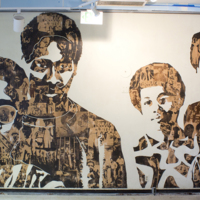
The Black Experience
In 1970, a group of seven black UCLA art students created a mural titled The Black Experience on the first floor of the Ackerman Student Union building. The mural, which measures 10 feet by 27 feet, was obscured for 20 years by a false wall erected in front of it during building renovations in 1992. Then in 2013, the mural was restored. “It was important in 1970, as it is today, to address issues of racial disparity on the UCLA campus,” one of the artists, Helen Singleton said. “Our mission in creating ‘The Black Experience’ mural was to expand and enhance that effort with a visual representation of the history and experience of African Americans in the United States.” The seven art students, Helen Singleton, Marian Brown, Neville Garrick, Andrea Hill, Jane Staulz, Joanne Stewart and Michael Taylor, are all depicted in the mural, alongside silk-screened graphics of the antislavery leaders Frederick Douglass and Harriet Tubman, alongside Martin Luther King Jr., Malcolm X, Bobby Seale, Huey P. Newton, Muhammad Ali, and Angela Davis. “We learned a lot about our history by exploring what images to use,” said Garrick, who was a freshman from Jamaica when he participated in the art project. In 2012, the effort to uncover the mural gained momentum after members of the Afrikan Student Union brought the mural to the attention of the Associated Students UCLA board of directors. At the unveiling in 2013, both Singleton and Garrick were guests of honour, along with activist Angela Davis.
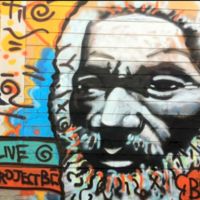
#projectbe / Exhibit BE
Brandan Odums’ murals are unusual because they tend to be off-limits to the public. One of the few muralists to reclaim dilapidated and abandoned building spaces as canvasses after Hurricane Katrina, Odums created a series of graffiti murals that aimed to inspire and provoke audiences. Although conscious of legal repercussions, Odums believed he had “a responsibility to influence people. If I see there’s a problem with a property that’s been sitting there for eight years, then I’m going to solve it within my own brain.” Turning a site of neglect into a site of pride, Odums used the Florida Housing Development in the Ninth Ward as his canvas for #projectbe, filling it wall-to-wall with portraits and quotations from figures that include the antislavery leader Frederick Douglass, Huey P. Newton, Nina Simone and James Baldwin. His artwork was deemed illegal due to his trespassing on private property. It was only seen in person by handful of visitors. After #projectbe ended, Odums embarked on a larger project at Degaulle Manor – a 360-unit apartment block. After speaking with the owner of the property, Odums was granted permission to temporarily use the building and invite the public. This project was called Exhibit BE. Around 35 street artists assisted and turned the abandoned building into one of the largest street exhibitions in the south, with 30,000 people visiting Exhibit BE in three months. The second mural of Douglass is from this exhibition.
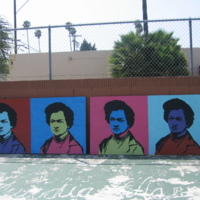
Frederick Douglass Academy Elementary School Mural
In 2014, muralist Maryanna Donnelly created this pop art style mural at the Frederick Douglass Academy Elementary School in Los Angeles.
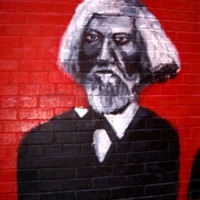
Paintin' the Town
In 1997, a muralist working for the Old Town Development Board completed a mural called Paintin’ the Town on North Loudoun Street in Winchester, Virginia. It includes a depiction of Douglass during the later period of his life. It had now been destroyed.
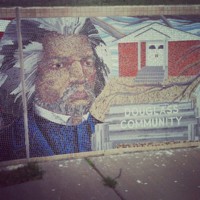
Tracks of Our Past and Future
In Plano, Texas, artists Lynne Chinn and Shug Jones created a mosaic mural titled Tracks of Our Past and Future. Made in 2006, the mural is 75 feet long and celebrates the African American community of Plano, Texas. At the centre of the mural is the antislavery leader Frederick Douglass.
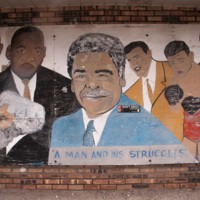
A Man and His Struggles
Titled A Man and His Struggles, this mural by Magic Fingers is in the Oak Park area of Chicago and depicts the first African American mayor of the city, Harold Washington, alongside Martin Luther King Jr., Jesse Jackson, and the antislavery leader Frederick Douglass. In 2016, artists updated the mural, to add the Pan-African flag along its bottom edge.
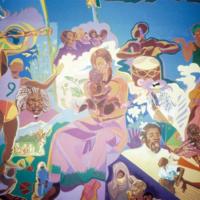
Races of the Student Population
In 1976, the Mexican muralist Manuel Martinez created a mural at Auraria College titled Races of the Student Population. It depicts the antislavery leader Frederick Douglass alongside figures of the Black Power Movement including Bobby Seale, and figures and symbols of the African diaspora.